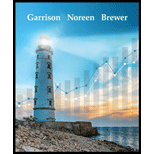
1.
:
The margin, turnover, and return on investment (ROI) of the company.
2.
Operating assets: Operating assets refer to those assets which are acquired by the company to support its ongoing business operations. These are the assets that contribute to generating revenue. For instance, cash,
:
The effect of reduction in the average level of inventory on the margin and turnover of the company and computation of the revised return on investment.
3.
Cost saving refers to the benefit realized by the company by reducing the overall spending or cost of conducting a business. Cost saving has a direct impact on the
:
The effect of the cost saving on the margin and turnover of the company and computation of the revised return on investment.
4.
Production costs: Production costs refer to the total costs incurred by an organization in order to manufacture a product or provide a service to the customers. Production cost includes both the direct cost as well as indirect costs. For example, raw materials, labor, general
:
The effect of the purchase of plant and machinery, reduction in production cost on the margin and turnover of the company, and computation of the revised return on investment.
5.
Sales revenue: Sales revenue is the amount earned by the company by selling goods or providing services to the customers. It is determined by multiplying the number of units sold with the selling price per unit. The amount of sales revenue is recorded under the head of gross revenue or net revenue in the income statement.
:
The effect of an increase of 20% in sales on the margin and turnover of the company and computation of the revised return on investment.
6.
Return on Investment or asset: It establishes the relationship between the net income and the assets or capital employed. The ratio is used to measure the overall performance of an organization by looking at how efficiently an organization uses its resources.
:
The effect of scrapped inventory on the margin and turnover of the company and computation of the revised return on investment.
7.
Cash and cash equivalents: Cash and cash equivalents are short-term or current investments that can be converted into a specific amount of cash quickly. An instrument that can be converted into cash within 3 months or less refers to a cash equivalent. In a
:
The effect of reduction in cash on the margin and turnover of the company and computation of the revised return on investment.
Want to see the full answer?
Check out a sample textbook solution
Chapter 11 Solutions
Managerial Accounting
- RoseBud Motel Ltd. (RM) had 100,000 ordinary shares outstanding during all of 2025, all owned by the owner Johnny Rose. In 2023, RM issued $500,000, 3% non-cumulative preferred shares. Each $100 preferred share is convertible into one ordinary share. RM also had 6,000, $100 cumulative preferred shares outstanding that are each entitled to an annual dividend of $1.60. Each preferred share is convertible into two ordinary shares. RM’s net income for the year ended December 31, 2025, was $400,000. Its income tax rate was 20%. The annual dividend was declared and paid during 2025 on the cumulative preferred shares but not on the non-cumulative shares. Required Calculate RM’s basic EPS for 2025. Are the non-cumulative convertible preferred shares dilutive or antidilutive in nature? The cumulative convertible preferred shares? Support your answer with calculations. Calculate RM’s diluted EPS for 2025.arrow_forwardGive correct answer this general accounting questionarrow_forwardHogwarts Inc. (HI) had 80,000 ordinary shares outstanding on January 1, 2025. Transactions throughout 2025 affecting its shareholdings follow. February 1: HI issued 200,000, $10, cumulative 10% preferred shares. March 1: HI issued 40,000 ordinary shares. April l: HI declared and issued an 8% stock dividend on the ordinary shares. July 1: HI repurchased and cancelled 30,000 ordinary shares. October 1: HI declared and issued a 3-for-l stock split on the ordinary shares. December 31: HI declared $99,600 in dividends on the ordinary shares. Net income for the year ended December 31, 2025, was $600,000. Its tax rate was 40%. Required What was the weighted average number of ordinary shares outstanding in 2025? What was the basic EPS in 2025? If the preferred shares issued on February 1, 2025, were non-cumulative, what would basic EPS for 2025 have been?arrow_forward
- What is the gross profit on these general accounting question?arrow_forwardIn the table below, choose the financial instrument to list on the left side that best explains the example on the right side. Types of financial instrument to select from: financial asset, financial liability, equity, compound instrument, basic option, swap, forward, future, warrant, put option, or call option. Type of financial instrument Example A company contracts with an investment bank to pay the bank prime rate + 1% interest on $25 million of debt in exchange for receiving 5% from the bank. Company Abacus issues $10 million debentures with warrants to purchase shares for $10/share within 8 years. A company contracts to sell 100 barrels of oil at $110/barrel in March on the Chicago Mercantile Exchange. Note payable A company purchases the right but not the obligation to purchase 5,000 shares in another company at $15 each over a 12-year period. Company X contracts to buy 1,000 oz of silver at $40/oz on March 15,…arrow_forwardGeneral Accountingarrow_forward
 Managerial Accounting: The Cornerstone of Busines...AccountingISBN:9781337115773Author:Maryanne M. Mowen, Don R. Hansen, Dan L. HeitgerPublisher:Cengage Learning
Managerial Accounting: The Cornerstone of Busines...AccountingISBN:9781337115773Author:Maryanne M. Mowen, Don R. Hansen, Dan L. HeitgerPublisher:Cengage Learning Cornerstones of Cost Management (Cornerstones Ser...AccountingISBN:9781305970663Author:Don R. Hansen, Maryanne M. MowenPublisher:Cengage Learning
Cornerstones of Cost Management (Cornerstones Ser...AccountingISBN:9781305970663Author:Don R. Hansen, Maryanne M. MowenPublisher:Cengage Learning Managerial AccountingAccountingISBN:9781337912020Author:Carl Warren, Ph.d. Cma William B. TaylerPublisher:South-Western College Pub
Managerial AccountingAccountingISBN:9781337912020Author:Carl Warren, Ph.d. Cma William B. TaylerPublisher:South-Western College Pub Financial And Managerial AccountingAccountingISBN:9781337902663Author:WARREN, Carl S.Publisher:Cengage Learning,Principles of Accounting Volume 2AccountingISBN:9781947172609Author:OpenStaxPublisher:OpenStax College
Financial And Managerial AccountingAccountingISBN:9781337902663Author:WARREN, Carl S.Publisher:Cengage Learning,Principles of Accounting Volume 2AccountingISBN:9781947172609Author:OpenStaxPublisher:OpenStax College Cornerstones of Financial AccountingAccountingISBN:9781337690881Author:Jay Rich, Jeff JonesPublisher:Cengage Learning
Cornerstones of Financial AccountingAccountingISBN:9781337690881Author:Jay Rich, Jeff JonesPublisher:Cengage Learning





